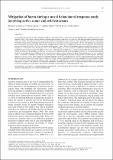Files in this item
Mitigation of harm during a novel behavioural response study involving active sonar and wild cetaceans
Item metadata
| dc.contributor.author | Southall, Brandon | |
| dc.contributor.author | Quick, Nicola Jane | |
| dc.contributor.author | Hastie, Gordon Drummond | |
| dc.contributor.author | Tyack, Peter Lloyd | |
| dc.contributor.author | Boyd, Ian Lamont | |
| dc.date.accessioned | 2018-05-10T10:30:14Z | |
| dc.date.available | 2018-05-10T10:30:14Z | |
| dc.date.issued | 2017-10-27 | |
| dc.identifier | 252625932 | |
| dc.identifier | b0a685ab-b6be-4041-b91f-d6eff1021fc9 | |
| dc.identifier | 85063079145 | |
| dc.identifier.citation | Southall , B , Quick , N J , Hastie , G D , Tyack , P L & Boyd , I L 2017 , ' Mitigation of harm during a novel behavioural response study involving active sonar and wild cetaceans ' , Journal of Cetacean Research and Management , vol. 16 , pp. 29-38 . | en |
| dc.identifier.issn | 1561-0713 | |
| dc.identifier.other | ORCID: /0000-0002-9773-2755/work/54819190 | |
| dc.identifier.other | ORCID: /0000-0002-8409-4790/work/60887835 | |
| dc.identifier.uri | https://hdl.handle.net/10023/13322 | |
| dc.description.abstract | Some studies of how human activities can affect wild free-ranging animals may be considered to have potential negative outcomes too severe to beethically studied. This creates a societal dilemma involving choices between continuing risky activities with high uncertainty about their potentialeffects on wildlife, often with considerable associated precaution or undertaking focused research to reduce uncertainty, but with some risk of harmfrom either strong response leading to potential stranding or direct physical injury from sound exposure. Recent and ongoing field experimentshave measured the conditions in which wild cetaceans respond to military sonar, and provided insight into the nature of responses. Here mitigationmeasures are reported for one of the first such experiments designed to measure fine-scale behavioural responses to controlled exposures of midfrequency(3–4 kHz) active sonar. The objective was to do so without causing the kinds of physical harm that have been previously observed (e.g.stranding events) and that motivated the study. A critical goal of this experimental study was to identify a response that was safe but that could beused as an indicator of the probability of risk from more extreme or sustained exposure from real military operations. A monitoring and mitigationprotocol was developed using a feedback control procedure for real-time mitigation of potential harm. Experimental protocols were modulatedrelative to indicators of potential risk with the explicit objective of detecting potentially harmful consequences of sound exposure and takingappropriate corrective action. Three categories of mitigation methods were developed and integrated within the experimental protocol incorporatingdesigned, engineered, and operational mitigation measures. Controlled exposure experiments involving free-ranging animals were conducted withoutany evident harm to the experimental subjects, while successfully eliciting behavioural responses that provided meaningful results to informmanagement decisions. This approach demonstrates the importance of careful design of protocols in exposure-response experiments, particularlyin pioneering studies assessing response where both the potential for harm and level of uncertainty may be high. | |
| dc.format.extent | 10 | |
| dc.format.extent | 317312 | |
| dc.language.iso | eng | |
| dc.relation.ispartof | Journal of Cetacean Research and Management | en |
| dc.subject | Acoustics | en |
| dc.subject | Conservation | en |
| dc.subject | Behavior | en |
| dc.subject | Management procedure | en |
| dc.subject | Short-term change | en |
| dc.subject | Beaked whales | en |
| dc.subject | Delphinids | en |
| dc.subject | Northern Hemisphere | en |
| dc.subject | GC Oceanography | en |
| dc.subject | GF Human ecology. Anthropogeography | en |
| dc.subject | QH301 Biology | en |
| dc.subject | NDAS | en |
| dc.subject | NERC | en |
| dc.subject.lcc | GC | en |
| dc.subject.lcc | GF | en |
| dc.subject.lcc | QH301 | en |
| dc.title | Mitigation of harm during a novel behavioural response study involving active sonar and wild cetaceans | en |
| dc.type | Journal article | en |
| dc.contributor.institution | University of St Andrews. School of Biology | en |
| dc.contributor.institution | University of St Andrews. Sea Mammal Research Unit | en |
| dc.contributor.institution | University of St Andrews. Centre for Social Learning & Cognitive Evolution | en |
| dc.contributor.institution | University of St Andrews. Marine Alliance for Science & Technology Scotland | en |
| dc.contributor.institution | University of St Andrews. Sound Tags Group | en |
| dc.contributor.institution | University of St Andrews. Bioacoustics group | en |
| dc.contributor.institution | University of St Andrews. Scottish Oceans Institute | en |
| dc.contributor.institution | University of St Andrews. Institute of Behavioural and Neural Sciences | en |
| dc.description.status | Peer reviewed | en |
| dc.identifier.url | https://archive.iwc.int/pages/search.php?search=%21collection15&k= | en |
This item appears in the following Collection(s)
Items in the St Andrews Research Repository are protected by copyright, with all rights reserved, unless otherwise indicated.

